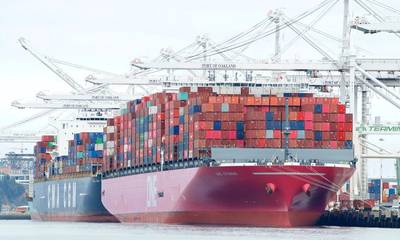US Trade Deficit Shrinks on Falling Imports
The U.S. trade deficit unexpectedly narrowed in November as imports of consumer goods fell to a one-year low amid slowing domestic demand, a trend that, if it persists in December, could result in trade having no impact on economic growth in the fourth quarter.
The report from the Commerce Department on Tuesday also showed exports declined in November amid cooling demand overseas. Demand is slowing both in the United States and abroad following hefty interest rate increases by global central banks since 2022 to tackle rampant inflation.
The Federal Reserve's rate hiking cycle has likely ended, with financial markets expecting the U.S. central bank to start lowering borrowing costs as soon as March.
"The weakness of both exports and imports in November suggests that weaker growth overseas is now being matched by a softening in domestic demand too," said Andrew Hunter, deputy chief U.S. economist at Capital Economics.
The trade deficit contracted 2.0% to $63.2 billion, the Commerce Department's Census Bureau said. Data for October was revised slightly to show the trade gap widening to $64.5 billion instead of the previously reported $64.3 billion.
Economists polled by Reuters had forecast the trade deficit would rise to $65.0 billion in November.
Imports declined 1.9%, or $6.1 billion, to $316.9 billion. Goods imports dropped 2.3% to $257.4 billion.
Imports of consumer goods fell $4.1 billion to the lowest level since November 2022, led by a $1.9 billion decrease in cell phones and other household goods.
There were also declines in imports of pharmaceutical preparations as well as industrial supplies and materials, which include petroleum products. But crude oil imports increased $1.5 billion. Capital goods imports decreased $0.7 billion, pulled down by declines in drilling and oilfield equipment, suggesting weak business spending on equipment persisted in the fourth quarter.
Exports decreased 1.9%, or $4.8 billion, to $253.7 billion. Goods exports dropped $5.4 billion to $168.0 billion, with industrial supplies and materials falling $3.6 billion as crude oil shipments slipped $1.0 billion. The decline was mostly because of lower oil prices.
Exports of those goods were also weighed down by decreases in non-monetary gold and organic chemicals.
Exports of motor vehicles, parts and engines also fell, likely as production lagged in the aftermath of strikes by the United Auto Workers union.
Consumer goods dropped to the lowest level since December 2022. But exports of capital goods were the highest on record.
Stocks on Wall Street were trading lower, while the dollar was higher versus a basket of currencies. U.S. Treasury prices rose.
Goods trade gap shrinks
The goods trade deficit narrowed 0.6% to $89.4 billion in November. When adjusted for inflation, the goods trade deficit contracted $2.3 billion, or 2.7%, to $84.8 billion. The so-called real goods trade deficit is so far averaging $86.0 billion in the fourth quarter, little changed from the third-quarter average.
Before the data, most economists were expecting that trade would exert a small drag on gross domestic product in the fourth quarter after it was neutral to the economy's 4.9% growth rate in the July-September quarter. Trade has not contributed to GDP growth for two straight quarters.
Economists at Goldman Sachs raised their fourth-quarter GDP growth estimate to a 1.5% rate from a 1.4% pace.
The drop in imports is in line with businesses throttling back on inventory accumulation in anticipation of slower demand this year following 525 basis points worth of interest rate hikes by the Fed since March 2022.
That is seen curbing growth in the fourth quarter. The government is scheduled to publish its snapshot of GDP growth for the October-December period later this month.
The goods trade deficit with China fell $2.4 billion to $21.5 billion, with imports declining sharply. Chinese imports typically drop in November, when most businesses would have completed their holiday shopping orders. Goods exports to China also decreased.
Economists saw limited impact on trade flows from disruptions in the Red Sea, where attacks on container ships by Iran-aligned Houthi militants have forced companies to reroute vessels, driving up costs sharply along with insurance premiums.
"Even if shipping disruptions in the Red Sea prove longer-lasting, the impact to U.S. trade is likely to be modest outside of the run-up in shipping prices," said Matthew Martin, a U.S. economist at Oxford Economics. "Drought-related delays to shipping through the Panama Canal is probably the bigger downside risk."
Imports of services fell $0.1 billion to $59.6 billion as an increase in travel was more than offset by a drop in transport.
Services exports rose $0.6 billion to a record high of $85.7 billion, lifted by travel, other business services, as well as transport and government goods and services. The services surplus of $26.2 billion was the highest since March 2018.
"The outlook for trade flows going forward is likely one of moderation, given the trajectory for demand and growth should slow, both domestically and abroad," said Rubeela Farooqi, chief U.S. economist at High Frequency Economics in White Plains, New York.
(Reuters - Reporting by Lucia Mutikani; Editing by Chizu Nomiyama and Paul Simao)











